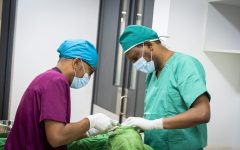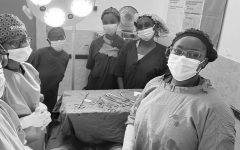Managing the Complexities of Food Security Among Refugees
October 16, 2017 2017-10-16 18:19Managing the Complexities of Food Security Among Refugees
October 16, marks World Food Day (WFD), an international event hosted by the United Nations’ Food and Agricultural Organization (FAO) to commemorate FAO’s initiation in 1945. In the seventy-two years since, FAO has worked in partnership with countless local and international organizations to end hunger worldwide.
This year for WFD, we highlight the work of two of our Master of Science in Global Health Delivery (MGHD) students: registered dietitian Marcella Canelo and physician Dr. Angeline Mumararungu. These Lions have worked directly to address issues of food security and malnutrition in Rwanda with Gardens for Health International (GHI). Marcella is currently a Teaching Assistant for UGHE’s Principles of Global Health Equity course and a former Program and Administrative Fellow at GHI. Angeline is GHI’s Health Manager and she currently leads the kitchen program in Mahama refugee camp.
Read their joint reflection below on how food security, nutrition, and conflict-related migration impact the health of thousands in Mahama refugee camp.
The world is currently facing the highest level of displacement ever recorded–65.9 million people have been displaced from their homes by conflict and persecution, 22.5 million of whom are listed as refugees with the office of the United Nations High Commissioner for Refugees (UNHCR). According to the World Food Programme (WFP), the majority of refugee families lack reliable access to a sufficient quantity of affordable and nutritious food, or are food insecure. Additionally, refugees lose self-sufficiency with migration as they often come from rural areas where food security is dependent on agriculture. With refugee and related food crises unfolding around the world, the United Nations’ Food and Agricultural Organization (FAO) announced this World Food Day as a time to recognize the intertwinement of migration, food security and rural development. A prime example of the overlap of these forces is seen in Mahama refugee camp.
As of February 2017, Rwanda was host to over 168,000 refugees, primarily from the Democratic Republic of the Congo and Burundi. Mahama refugee camp, located in Kirehe, Eastern Province, Rwanda, is home to over 55,000 Burundian refugees and has been growing steadily since its opening in April 2015. In our first year as students with UGHE’s MGHD program, we visited Mahama to see firsthand the realities of managing refugee health. With many organizations operating there, multidisciplinary collaboration is vital for successful management of refugees’ food security.
Globally, basic food security and nutritional needs for refugees are typically met through food assistance provided by the World Food Programme (WFP) and partners. In Mahama, all refugees are entitled to rations of maize, corn soya blend, beans, salt, and cooking oil. While the food rations distributed in Mahama may be enough to fill one’s caloric needs, they lack dietary diversity and may not provide key vitamins and minerals necessary to refugees’ health. To prevent micronutrient deficiencies in refugees, WFP fortifies many of its foods, like its corn soya blend, which contains vitamin A, iodine, iron and other nutrients. Nevertheless, chronic malnutrition is still common among Mahama’s refugees and children, in particular.
An additional issue of concern with food rations within refugee camps is that recipients do not have a choice in what they consume. This commonly results in the selling or trading of food rations, often at a reduced price, so that refugees can buy the foods that they actually want to eat, originating outside of the camp. Recently, WFP and other partners have transitioned from food rations to cash transfers in some camps, so that refugees can purchase their own food instead of relying of food that is given to them. According to UNHCR, this has many benefits, including more autonomy for refugees and a boost in the local economy. While Mahama still follows the food ration model, other camps in Rwanda, like Kigeme in the Southern Province, are starting to follow the cash transfer model. Nutrition education can help families make better, more informed choices whether they are buying food with cash or trading with rations. Still, without also increasing access to nutritious foods, education is not enough. This is where local organizations and partners can play a big role in investing in food security and rural development.
To address the challenges faced by Mahama’s refugees to obtain food that is adequate in both quantity and nutritional quality, the camp is supported by various organizations like Rwanda’s Ministry of Disaster Management and Refugee Affairs (MIDIMAR), UNHCR, Save the Children, and the American Refugee Committee. With these partners, Mahama is supported by diverse teams that can dissect issues of nutrition, sanitation and hygiene, agriculture, climate change, environmental health, value chain and more so that refugees receive resources crucial to their quality of life. In particular, we have both worked with the nonprofit GHI, which has recently begun integrated agriculture, health and nutrition training for Mahama refugees through its kitchen garden model.
The kitchen garden program, a hallmark of GHI that has been tested across Rwanda, starts by identifying families with children who suffer from acute or chronic malnutrition. In Mahama, these families are then provided with agricultural training and resources like seeds to begin and maintain their garden, using land allocated by camp management upon arrival. The selected families also receive support through home visits and health education to understand how to shop for and prepare balanced meals, as well as how to practice good hygiene to avoid health problems like diarrheal diseases, which can be deadly for malnourished children. Once established, kitchen gardens increase food and nutrition diversity for refugees, promote self-sufficiency for vulnerable households and can even serve as a source of income to families with productive gardens. Thus far, GHI has provided this kitchen garden training to more than four hundred families with seriously malnourished children in Mahama. With continued emphasis on sustainable rural development and empowerment of refugees through models like the kitchen garden program, an end to hunger for the most vulnerable in Rwanda may be closer than we think.
Mahama, like other refugee camp settings, faces constant food security challenges. As such, it is a clear example of why this World Food Day’s theme revolves around the impact of conflict-related migration on food security and rural development. Nevertheless, our time working with GHI and observing other organizations operating in Mahama has revealed the importance of multidisciplinary partnerships to create innovative, context-appropriate solutions to support refugee health. Furthermore, as UGHE students exploring the roles of equity and global health leadership in this process, we are reminded that the mission to treat all people with dignity can and must drive the movement to improve the livelihood of refugees and end hunger worldwide.
To learn more about World Food Day and how you can help end hunger worldwide, visit the Food and Agricultural Organization of the United Nations’ website here, and join the online conversation for #ZeroHunger.







